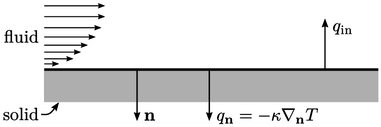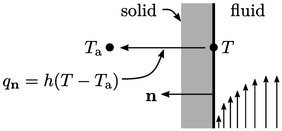4.17 External wall heat flux
The boundary condition for temperature (or energy) dictates the heat transfer across a boundary. At a boundary that represents a solid wall, simple conditions can sometimes be applied. However, specialised boundary conditions are often required that control the heat flux across the boundary.

The fixed
temperature is the simplest condition, setting a fixed value
 .
This condition provides an approximation for cases for a solid with
high thermal mass, due to a large mass of material and high
conductivity
.
This condition provides an approximation for cases for a solid with
high thermal mass, due to a large mass of material and high
conductivity  , which helps to maintain constant
, which helps to maintain constant  .
.
Otherwise the boundary condition sets the heat
flux normal to the boundary,  derived from
Eq. (2.54
) by
derived from
Eq. (2.54
) by
 |
(4.28) |
 . This is the
adiabatic condition, corresponding to zero normal heat flux by
Eq. (4.28
), suitable when the solid
is a thermally insulating material with a large mass and low
. This is the
adiabatic condition, corresponding to zero normal heat flux by
Eq. (4.28
), suitable when the solid
is a thermally insulating material with a large mass and low
 .
.
Otherwise a fixed
heat flux condition specifies an
inward heat flux
 as
a fixed gradient type with a reference gradient by
as
a fixed gradient type with a reference gradient by
 |
(4.29) |
Fixed heat transfer coefficient
Another way to specify the heat transfer at an
external wall is by Newton’s law of cooling.7 This
general law states the rate of heat loss of a body is directly
proportional to the difference between the body temperature
 and a surrounding, ambient temperature
and a surrounding, ambient temperature  .
.

Applied as a boundary condition,  is the fluid
temperature at the boundary, and
is the fluid
temperature at the boundary, and  a temperature some
distance beyond the solid boundary. A heat transfer coefficient
a temperature some
distance beyond the solid boundary. A heat transfer coefficient
 ,
with SI units
,
with SI units  , provides the constant of proportionality such
that
, provides the constant of proportionality such
that
 |
(4.30) |
 |
(4.31) |
 is typically
characterised for the particular flow regime and solid boundary, by
some estimate, experimental measurements or computer simulation.
is typically
characterised for the particular flow regime and solid boundary, by
some estimate, experimental measurements or computer simulation.

